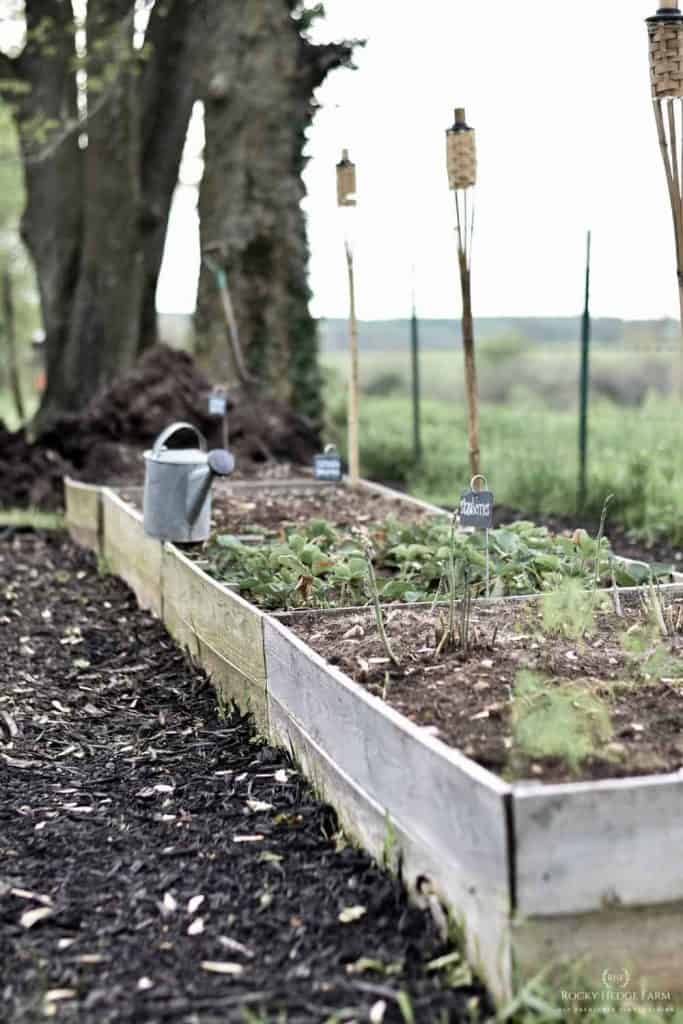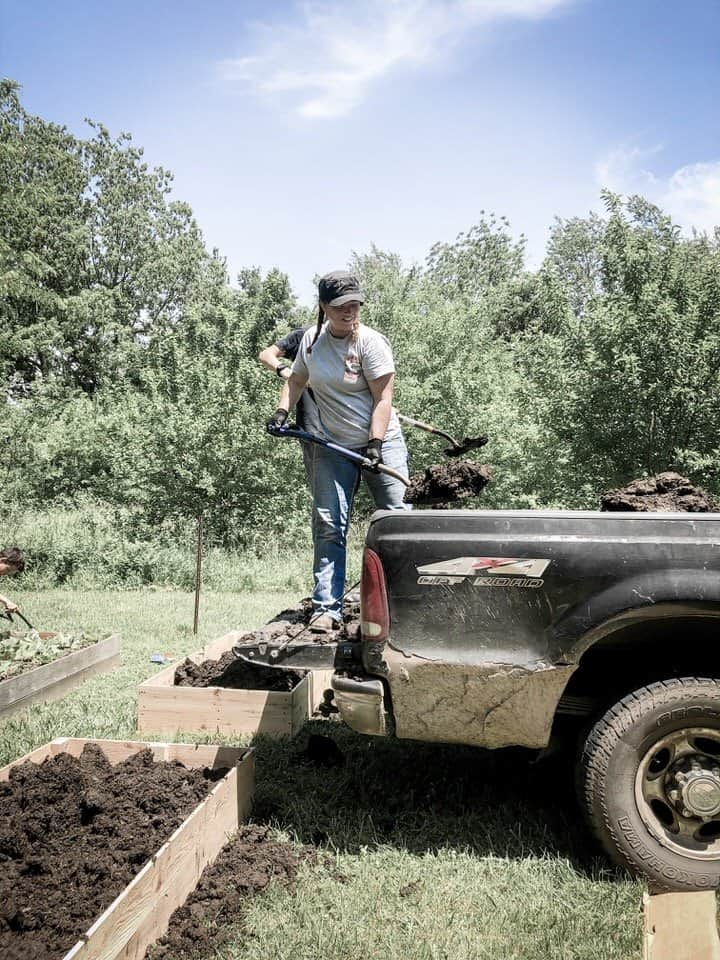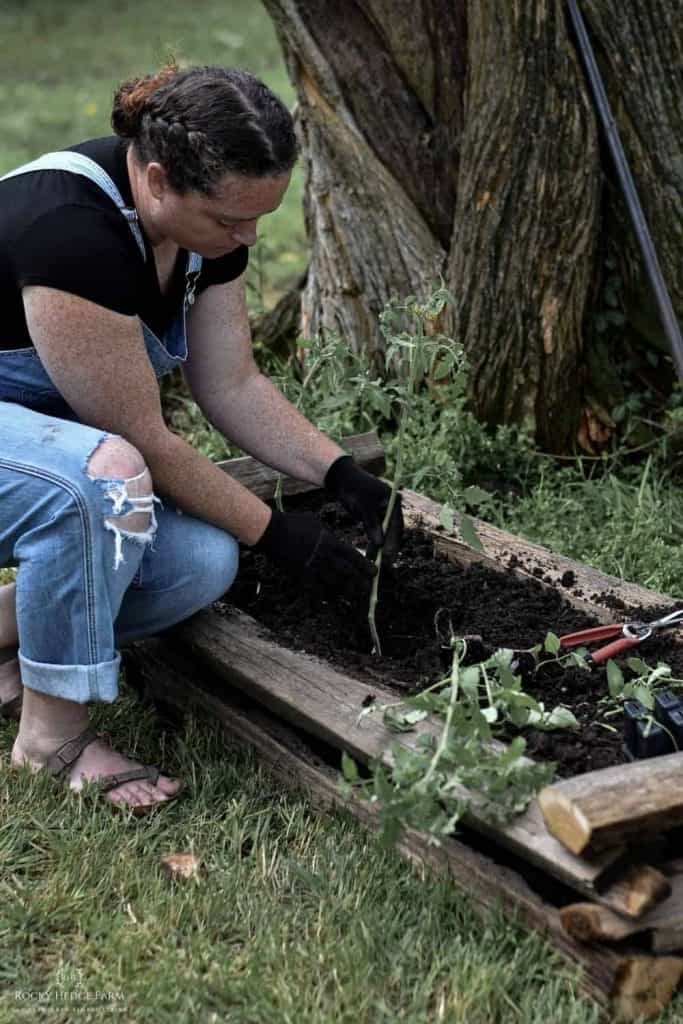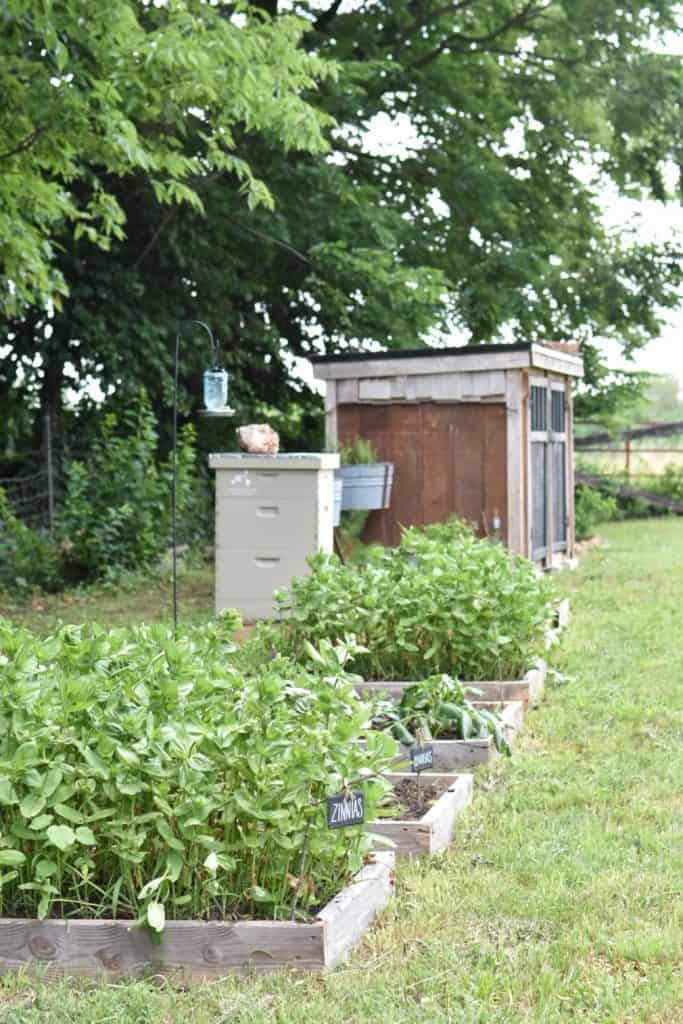How to Start a Garden from Scratch for Beginners
Starting a garden from scratch may seem overwhelming, but it does not have to be. With a basic knowledge and hard work, anyone can create a beautiful and thriving garden.
Here is how to start a backyard vegetable garden from scratch with beginners’ gardening steps.

Starting a vegetable garden from scratch can feel daunting, but it is gratifying to grow your own food.
Have you ever tasted homegrown vegetable produce? There isn’t anything quite like the flavor of freshly harvested produce.
The great news is that you can start your own vegetable garden from scratch as a beginning gardener. Then, relish that you can grow your own fresh vegetables year after year.

How to Start a Vegetable Garden in Your Backyard
Growing a backyard garden is such a rewarding experience. I want you to know the excitement of planting the seed, watching it sprout, seeing the vegetable growing, and then being able to harvest the produce.
Here are the easy steps to follow to start a vegetable from scratch.
Choose a Garden Location
When selecting a garden location, there are essential factors to remember. If you are starting a garden from scratch, you can choose the best spot on your property to put a garden in the ground.
Find a Location with Full Sunlight
Go out to your yard and take a look around. Where do you see the full sun during the morning, afternoon, and evening? This is the first step in locating the best place to start a garden.
Most vegetables need around 6 hours of sunlight each day. Where you find the most sunshine throughout the day is where you will want to plan for the location of your vegetable garden space.
Another thought to consider is the garden’s location is the drainage for water. Planting in an area that floods or dries out quickly would be an area to avoid.
So, choosing a sunny available space with good drainage is important.

Make Your Garden Easily Accessible
When planning your garden, it is important to consider accessibility. You will spend time in your garden, tending, watering, and harvesting your crops.
One way to ensure accessibility is by creating pathways or walkways around your garden beds. These paths will provide easy access to all sides of your beds, making it easier to tend to your plants.
You can create paths using mulch, gravel, or stepping stones.
Another factor to consider when starting a garden from scratch is the distance between your garden and home. The closer your garden is to your house, the easier it will be to access it regularly.
If your garden is far away, you may be less likely to visit it frequently, leading to neglect and poor plant growth.
Click here to learn how to create a beautiful garden at home!

Choose Your Garden Bed Type
Garden beds are the main element of any garden, and there are several different methods. Raised beds, container gardens, and in-ground beds are the most common garden bed types.
Each has advantages and disadvantages, depending on the available space, soil quality, and gardening goals.
In Ground Gardening
In years past, I have used the traditional gardening method of planting in the ground using traditional rows. It is cost-effective and easy to start and change if needed.
The downside to in-ground gardening is the weeds. The weeds will be the number one enemy as you work to keep them out of the garden.
Also, It will often take longer for the soil to warm in early spring, making it take longer to get seeds in the ground.

Raised Bed Gardening
Raised garden beds can be made from wood, timber, bricks, or rocks. Wood can be costly, and once they are in place, it is a commitment to leave them there.
The advantage of raised beds is the soil often warms faster in the spring. Raised garden beds also allow for better water drainage and are easier to reach.
Keeping weeds out of raised beds is much easier than the traditional in-ground method.
Click here to see how to build raised garden beds.

Container Gardening
Many vegetables can be grown in containers. This is a great way to maximize space, especially for those who want to garden in a small space, such as on balconies or a patio.
The downside to a container garden is the pots can be costly, and the soil tends to dry out quickly.
Back to Eden Gardening
Back to Eden gardening is a gardening method I have researched and am interested in. It’s a way of gardening I hope to eventually add to my current way of growing vegetables as we expand our garden.

Choose Your Soil
The soil in your garden is the key to the success of your garden plants. Plants need nutrient-rich, healthy fertile soil to grow.
Start with well-drained soil and plan to add as much organic materials as possible. Compost and well-aged manure will increase the ability of your soil to drain and hold in moisture.
Soil for Container Gardening
For container gardening, look for a high-quality potting mix. It will provide excellent drainage, aerating, and water retention. To improve soil structure, they usually contain a blend of organic matter, such as peat moss, compost, and perlite or vermiculite.
Raised Bed Soil
Building raised beds allows for complete control over soil quality, but buying bags of soil from garden centers can be expensive.
A more affordable option is purchasing bulk soil and compost from a reputable source or creating a soil mix with topsoil and organic matter.
Another sustainable option is sourcing aged manure from a local farm or livestock owner. But ensure it has thoroughly been composted to avoid introducing harmful pathogens or weed seeds to your garden.
In Ground Garden Soil
Generally, good soil for starting a vegetable garden from scratch is a well-draining loam rich in organic matter. Loam is a soil type that contains sand, silt, and clay, balancing drainage and water retention.
Organic matter, such as compost, helps improve soil structure, adds nutrients, and promotes beneficial microbial activity.
Before planting, testing your soil to determine its pH level and nutrient content is a good idea. Soil pH measures acidity or alkalinity, with most plants growing best in a slightly acidic range of 6.0 to 7.0.
If your soil is outside this range, you may need to make amendments to adjust it. You can add sulfur and organic matter to make garden soil more acidic. Add lime, wood ash, or poultry manure to alkaline the soil.
Know Your Frost Dates
Many new gardeners are anxious to start planting when the weather gets nice. However, getting plants in the garden at the right time for your growing season is an essential first step to a successful vegetable garden.
Knowing your local frost dates will help prevent frost damage from varying spring weather temperatures.
The Farmers Almanac is an excellent resource for determining when your first and last frost dates are for the gardening zone.

Have a Water Source
Water needs to be easily accessible as it is essential for the growth and health of your plants. It is best to choose a garden located near a water source.
If your garden is far from a water source, you may need to take additional steps to ensure plants receive adequate water. Nothing will cause a gardener to experience burnout faster than carrying water to thirsty plants when the temperatures are hot.
One solution is to use a hose or a nearby spigot to water your garden; this is a simple and convenient option, as you can easily connect a hose to a spigot and water your plants as needed.
Another option is to use a watering can. This is a good choice if you have a small garden or several container gardens.
If you have a larger garden, you may want to consider investing in a drip irrigation system. This system delivers water directly to the roots of your plants, reducing water waste and ensuring that your plants receive the right amount of water.
Other ideas for easy access to water include:
- Installing a rain barrel or water storage tank to collect rainwater
- Use a soaker hose
- Attach sprinklers to water hoses
Garden Tools
Garden tools can be costly, but buying the best quality tools your budget will allow can go a long way in getting the most out of what you have spent.
Start small in the number of tools you own; it’s easy to go above and beyond what you will generally use.
The top essential tools to get you going on any gardening endeavor are:
- garden gloves
- a hand trowel
- spade
- garden hoe
- garden hose with a nozzle,
- wheelbarrow
- slate plant labels

How to Plant a Garden From Scratch
Once you have finalized your garden plan, it is time to start the enjoyable task of planting. You can start your garden from seed by germinating them indoors or sowing them directly. Another option is to buy young plants from a nearby garden center nursery.
Start From Seeds
Some vegetables are considered slow-growing and are best grown from seeds. All of my seeds are started inside with organic seed starting mix. Vegetables like broccoli, cabbage, cauliflower, peppers, and tomatoes are best started from seed.
Some of the easiest vegetables are quick-growing, such as peas, squash, and green beans. These do best being direct seeded into the garden.
Vegetables with long taproots, like carrots, don’t transplant well and must be directly seeded into the garden.
Read your seed packets for the best results in planting seeds. All the information you need will be on the back of the package.
Information, such as how deep to plant the seeds, how long it takes to sprout, and how far apart to space the seeds are located on the back.
Start with Transplants
One benefit of using transplants to start your garden from scratch is that they save time. Instead of starting seeds indoors or directly planting seeds outside, you can purchase plants ready to go in the ground.
This is especially helpful if you live in an area with a shorter growing season. This allows you to get your plants in the ground earlier and take advantage of more of the growing season.
When selecting translates, it is important to choose healthy plants. Look for sturdy stems and leaves; avoid those that look weak or wilted.
Inspecting the plant’s roots to ensure the root system is not root-bound, which can hinder growth, is also a good idea.

Gardening From Scratch | Maintenance
Maintaining a vegetable garden involves several important tasks to ensure your plants’ health and productivity. Here are some steps to help you maintain your vegetable garden:
- Water regularly: Vegetables need consistent moisture to grow properly. Water your plants deeply and regularly, especially during dry spells or when temperatures are high.
- Mulch: Mulching helps retain moisture in the soil and suppress weeds, which can compete with your plants for water and nutrients.
- Fertilize: Vegetables are heavy feeders and require regular fertilization to thrive. Use a balanced fertilizer or compost to give your plants the necessary nutrients.
- Weed: Weeds can quickly take over a garden and compete with your plants for resources. Remove weeds regularly by pulling them by hand or using a hoe or cultivator.
- Prune: Pruning helps promote healthy growth and prevents overcrowding in your garden. Regularly prune your plants by removing dead or diseased foliage.
- Control pests and diseases: Monitor your garden for signs of pests or diseases, and take action as needed. Use organic methods like handpicking pests or insecticidal soap to control insect pests and remove diseased plants promptly to prevent the spread of disease.
- Harvest: Regularly harvest your vegetables to encourage continued growth and productivity. Gather at the right time to ensure the best flavor and quality.
Tips for How to Start a Garden From Scratch
Start Small: It’s easy to get overwhelmed with all the care a garden can need. Start small and add more as you find you need the space. When I built my first garden beds, the first year I started with four; then I added four more the next year.
Only Grow What You Will Eat: Unless you plan on giving away or selling a lot of produce, only grow what you know your family can eat. Plants such as squash, zucchini, and cucumbers produce a lot of vegetables.
Garden Journal: Keeping a garden journal is a fun, simple way to track your garden’s progress through the seasons. It’s easy to lose track of what day you planted or the name of the seeds you planted. Journal entries don’t have to be elaborate but provide a way to reflect on the information you need.
In keeping a garden journal, I find it helpful to write down the names of the seeds I have started and the date they were planted.
Other information may include the day the seed sprouted when harvesting the vegetable began, how much harvest was brought in, and final thoughts on the taste.
These factors will help you decide if this is a variety you would like to grow again in your garden for the next year.
Knowing where your vegetables come from is one of the most rewarding homesteading tasks. I hope this guide gives you the courage to start your first vegetable garden.
More Gardening Inspiration You Will Love
In this post, I have shared some essential tips and ideas to consider if you are starting a vegetable garden from scratch. Here are some other posts you may enjoy.









This is awesome info! I love your clothes! Can you tell me where you got your dress and overalls? I look forward to reading more of your posts.
Hello! My dress is from a local thrift shop and the overalls are from American Eagle.